
St Crux is a parish hall in York, in England, which incorporates the remains of a Mediaeval church.

St Crux is a parish hall in York, in England, which incorporates the remains of a Mediaeval church.
The building is on Pavement, although it is entered from The Shambles, while it backs onto Whip-Ma-Whop-Ma-Gate. [1]
St Crux was first mentioned in the Domesday Book, at which time it belonged to the Count of Mortain, later passing to St Mary's Abbey. The church was rebuilt between 1402 and 1424, incorporating a Saxon carved stone into the north wall. [1] [2] The tower was rebuilt from 1697, and Francis Drake described the Italianate tower as "a handsome new steeple of brick coined with stone". Although the church was regarded as one of the finest in the city, by the 19th-century, it was in a poor condition, and it was closed in 1880; the parish was soon merged into that of All Saints' Church. Fisher and Hepper drew up plans in 1884 to restore the church, but it was instead demolished three years later, over the objections of the Society for the Protection of Ancient Buildings. Despite the poor condition of the tower, it proved sturdy enough that it had to be dynamited. The Press has described it as "perhaps the most famous" lost church of York. [1] [3]

In 1888, a parish hall was built on the site of St Crux, reusing materials from the church, including much of its north wall, and the Perpendicular east window. Inside are many of the monuments and fixtures from the former church. Burials include Thomas Percy, 7th Earl of Northumberland, Sir Thomas Herbert, and two Lord Mayors of York: Thomas Bowes and Robert Welles. [1] [4]

The building was grade II* listed in 1954. [5] It is used as a tea room, and for charity markets. [6]

Selby Abbey is a former Benedictine abbey and current Anglican parish church in the town of Selby, North Yorkshire, England. It is Grade I listed.
York had around 45 parish churches in 1300. Twenty survive, in whole or in part, a number surpassed in England only by Norwich, and 12 are used for worship. This article consists of a list of medieval churches which still exist in whole or in part, and a list of medieval churches which are known to have existed in the past but have been completely demolished.
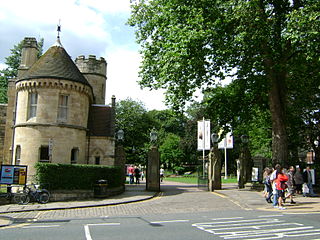
The York Museum Gardens are botanic gardens in the centre of York, England, beside the River Ouse. They cover an area of 10 acres (4.0 ha) of the former grounds of St Mary's Abbey, and were created in the 1830s by the Yorkshire Philosophical Society along with the Yorkshire Museum which they contain.

Leeds Minster, or the Minster and Parish Church of Saint Peter-at-Leeds is the minster church of Leeds, West Yorkshire, England. It stands on the site of the oldest church in the city and is of architectural and liturgical significance. A church is recorded on the site as early as the 7th century, although the present structure is a Gothic Revival one, designed by Robert Dennis Chantrell and completed in 1841. It is dedicated to Saint Peter and was the Parish Church of Leeds before receiving the honorific title of "Minster" in 2012. It has been designated a Grade I listed building by Historic England.

St Mary's Church is an active Anglican parish church located in Monk's Lane, Acton, a village to the west of Nantwich, Cheshire, England. Since 1967 it has been designated a Grade I listed building. A church has been present on this site since before the time of the Domesday Survey. The tower is the oldest in Cheshire, although it had to be largely rebuilt after it fell in 1757. One unusual feature of the interior of the church is that the old stone seating around its sides has been retained. In the south aisle are some ancient carved stones dating back to the Norman era. The architectural historian Alec Clifton-Taylor includes the church in his list of 'best' English parish churches. In the churchyard is a tall 17th-century sundial. The church is an active Anglican parish church in the diocese of Chester, the archdeaconry of Macclesfield and the deanery of Nantwich. Its benefice is united with those of St David, Wettenhall, St Oswald, Worleston, and St Bartholomew, Church Minshull.
Bossall is a hamlet in the Ryedale district of North Yorkshire, England with fewer than 100 residents. The Church of St Botolph was built in the 12th century with later alterations and is a Grade I listed building. The term Bosall was drawn from the name of 7th-century bishop Bosa of York who was said to have built a church here.
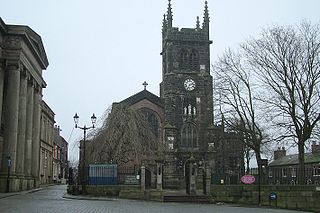
St Michael and All Angels Church overlooks Market Place in the town of Macclesfield, Cheshire, England. It is an active Anglican parish church in the diocese of Chester, the archdeaconry of Macclesfield and the deanery of Macclesfield. It forms a team parish with three other Macclesfield churches: All Saints, St Peter's and St Barnabas'. The church is recorded in the National Heritage List for England as a designated Grade II* listed building.

St Alphege or St Alphage London Wall was a church in Bassishaw Ward in the City of London, built directly upon London Wall. It was also known as St Alphege Cripplegate, from its proximity to Cripplegate. It is now operated as St Alphege Gardens.

St Peter le Poer was a parish church on the west side of Broad Street in the City of London. Of medieval origin, it was rebuilt in 1540, and again in 1792 to a design by Jesse Gibson with a circular nave. It was demolished in 1907.

Wakefield Cathedral, or the Cathedral Church of All Saints in Wakefield, West Yorkshire, England, is a co-equal Anglican cathedral with Bradford and Ripon Cathedrals, in the Diocese of Leeds and a seat of the Bishop of Leeds. Originally the parish church, it has Anglo Saxon origins and, after enlargement and rebuilding, has the tallest spire in Yorkshire. Its 247-foot (75 m) spire is the tallest structure in the City of Wakefield. The cathedral was designated a Grade I listed building on 14 July 1953.
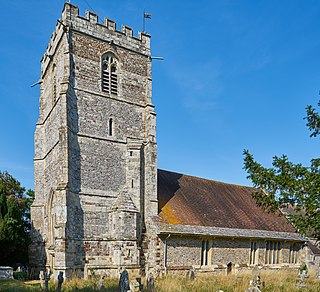
Cranborne Priory is a former priory church in the village of Cranborne, Dorset, England. Founded in 980 as Cranborne Abbey, it became a priory in 1102, remaining that way until it was dissolved in 1540. The tower, nave and aisles from the priory survive to from the Church of St Mary and St Bartholomew, the parish church of Cranborne. The building, which has fragments from the 12th century, is designated a Grade I listed building.

York Carmelite Friary was a friary in York, North Yorkshire, England, that was established in about 1250, moved to its permanent site in 1295 and was surrendered in 1538.

St Mary's Church is in the town of Kirkby Lonsdale, Cumbria, England. It is an active Anglican parish church in the deanery of Kendal, the archdeaconry of Westmorland and Furness, and the diocese of Carlisle. Its benefice is united with those of six local churches to form the Kirkby Lonsdale Team Ministry. The church contains Norman architecture and is recorded in the National Heritage List for England as a designated Grade I listed building.

St Nicholas Church, Sutton, is a Grade II* listed parish church in the centre of Sutton, London. It was built between 1862 and 1864 in the Gothic style with dressed flint and stone dressings. It was designed by the architect Edwin Nash.

St Mary's Church is an Anglican parish church in the English village of Welwick in the East Riding of Yorkshire. It is a Grade I listed building.
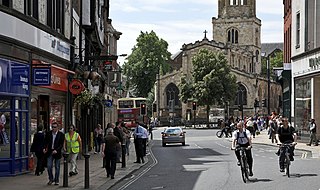
Pavement is a street in the city centre of York, in England.
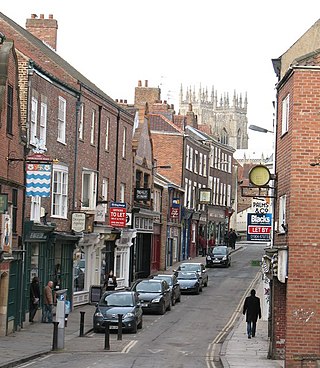
Fossgate is a street in the city centre of York, in England.

St Sampson's Church is a former parish church in the city centre of York, England. It lies on Church Street, near St Sampson's Square.

All Saints' Church is a Church of England parish church in Tarrant Keyneston, Dorset, England. Most of the church dates to a rebuild of 1852–53, but the tower is 15th-century. The church is a Grade II* listed building.

Bedern is a street in the city centre of York, in England, which originated as a college for the vicars choral of York Minster.